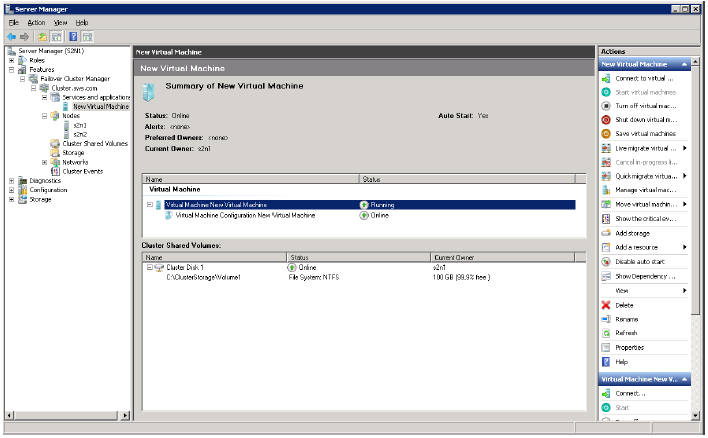
INTRODUCTION
Software clustering technology allows a group of systems function as unified redundant network resource. There are different cluster configurations that can be implemented, though a failover cluster is one of the most frequently used. Its High Availability (HA) configuration assumes that if one of the cluster nodes fails, the reserved node automatically comes online, providing little or no application downtime. With this type of configuration, user workflow remains virtually uninterrupted and secured.
Failover cluster configuration requires two or more server nodes that share an external storage. Based on the iSCSI technology, the StarWind solution enables creation of an external storage system in the Windows environment without expensive Fiber Channel or external SCSI solutions. With StarWind you can create a shared disk array on a host running Microsoft Windows Server.
This document provides step-by-step instructions on configuring StarWind Native SAN with Hyper-V and failover clustering.
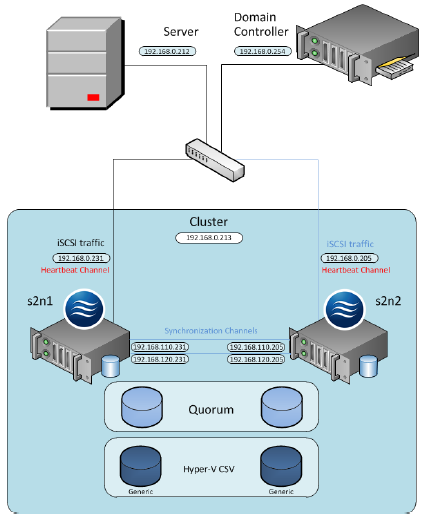
CONFIGURING SHARED STORAGE
1. Launch StarWind Management Console by clicking Start -> All Programs -> StarWind Software -> StarWind -> StarWind Management Console.
Note: The StarWind Console icon appears in the system tray, when the Console is running. To open StarWind Management Console, double-click the icon, or right click it. Then select Start Management Console from the Shortcut menu.
2. From the Console tree, select the server you want to provide with the iSCSI target device.
3. Double-click the host to connect.
4. You will be prompted to enter login and password. The default login and password are “root” and “starwind”. You can always change them later.
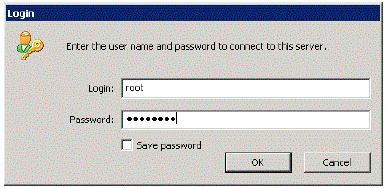
Note: Optionally select the Save password checkbox to save a password.
5. Click OK to continue.
6. Click Add Target on the toolbar.
7. Add Device Wizard appears. Please, follow the wizard’s steps to complete creation of a new HA device.
8. Go to Hard Disk->Advanced Virtual->High Availability Device to select the HA device type.
9. Click Next to continue.
10. In the Target Alias and Target Name text fields, specify corresponding information. The name must be unique. Under this name the device is declared to the iSCSI initiators, connecting to the StarWind Service over an IP network.
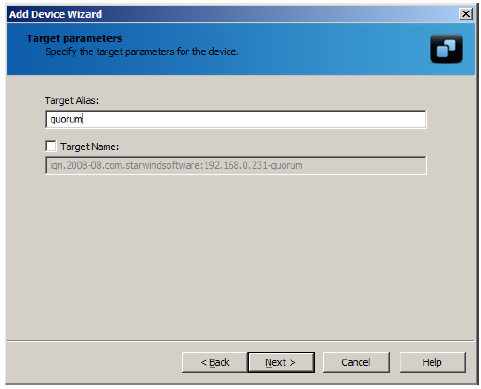
11. Click Next to continue.
12. Specify the partner server parameters. Enter the server’s IP-address in the Host text field, and specify username and password for the StarWind Service in the corresponding text fields.
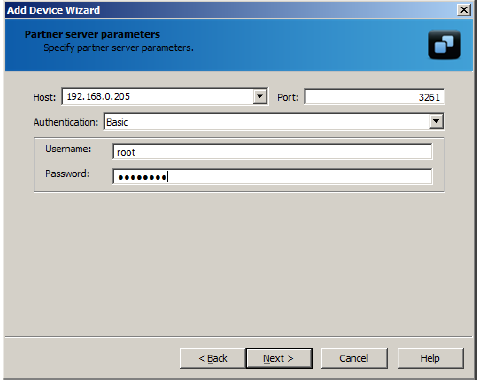
13. Click Next to continue.
14. In the Partner Target Alias and Partner Target Name text fields specify corresponding information.

15. Click Next to continue.
16. In the Virtual disk parameters of the current server field and the Virtual disk parameters of the partner server field specify name and location of HA virtual disks on the current and partner hosts, respectively. Click for that purpose.
If you want to create new virtual disks, select the Create New checkbox.
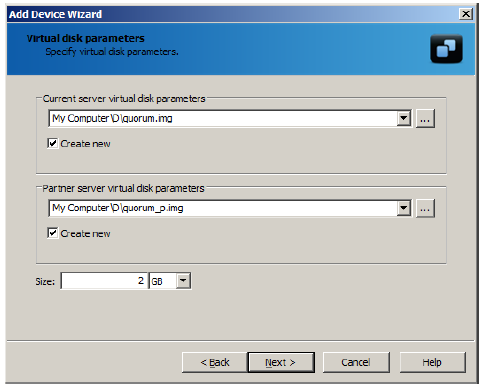
17. Click Next to continue.
18. Configure the data synchronization and heartbeat channels parameters of the current server. You can also specify Primary or Secondary node priority.

19. Click Next to continue.
20. Specify synchronization channel parameters of the partner server.
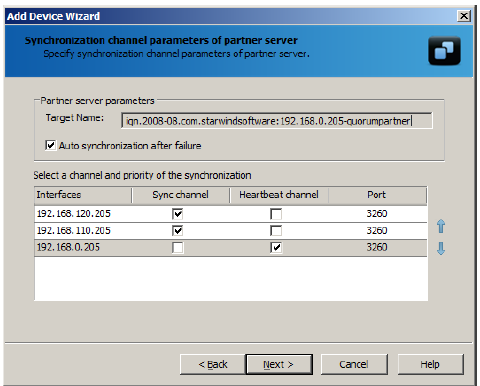
21. Click Next to continue.
22. Specify number of iSCSI sessions in the synchronization channel.
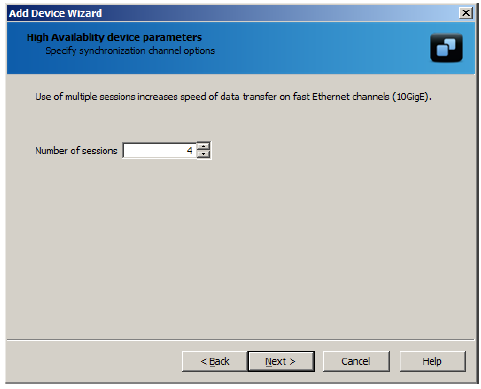
23. Click Next to continue.
24. Select initialization method of the HA device.
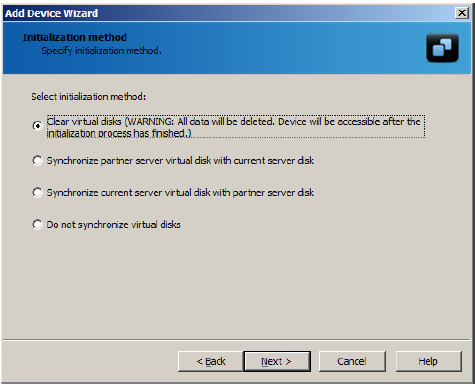
25. Click Next to continue.
26. Specify cache parameters of the HA device.
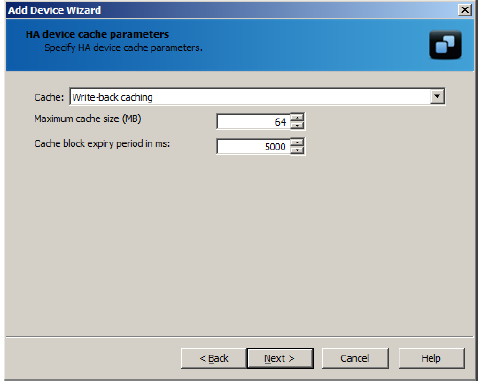
27. Click Next to continue.
28. Check whether device parameters are correct. Click Back to make any changes.
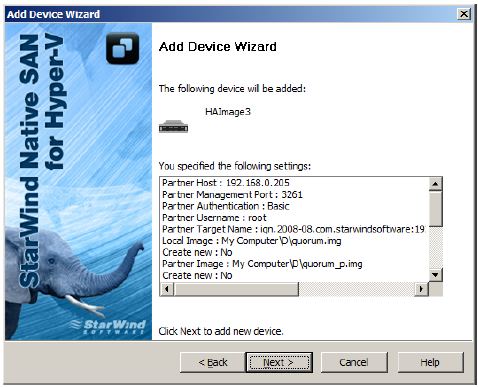
29. Click Next to continue.
30. Click Finish to close the wizard.
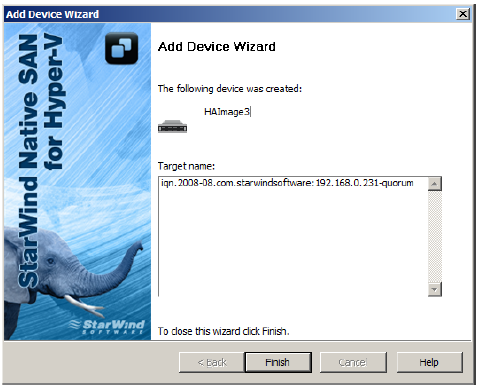
Follow the same procedure to create the second device, that’ll be used as cluster storage.
CONFIGURING HYPER-V SERVERS
This document assumes that you already have configured Active Directory and two servers in the domain. Besides, you are expected to have the Failover Clustering, Multipath I/O features enabled, as well as the Hyper-V role installed on both servers.
You can configure these features in the Features and Roles sections of Server Manager.
1. Launch Server Manager, select the Features item and click the Add Features link.
2. Add Features Wizard appears. Select Multipath I/O and Failover Clustering features checkboxes and follow the wizard’s instructions.
Note: Restart the server after installation is completed. Do not restart both nodes at the same time! First, restart one node, and wait until the device synchronization process is finished. Then, restart the second node.

3. Launch Server Manager, select the Server Roles item, and click the Add Roles link.
4. Add Roles Wizard appears. In the Roles section, select the Hyper-V checkbox and follow the wizard’s instructions.
Note: Restart the server after installation is completed. Do not restart both nodes at the same time! First, restart one node, and wait until the device synchronization process is finished. Then, restart the second node.
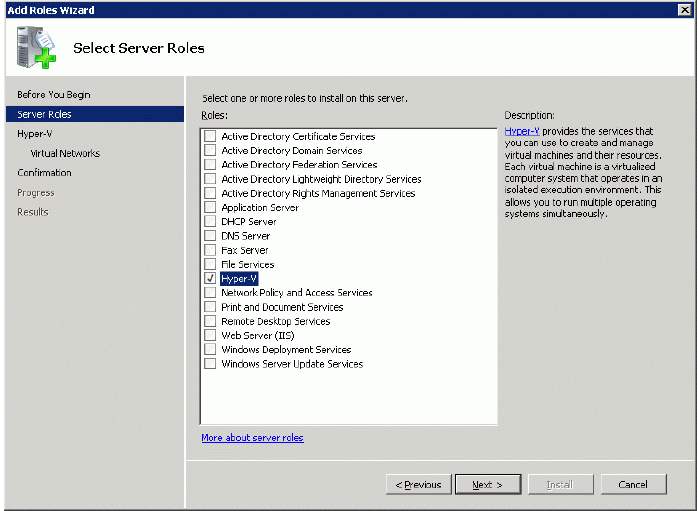
Connecting Targets
This step implies connection of previously created disks of all the servers which make up the cluster.
1. Launch Microsoft iSCSI Initiator and click the Discovery tab.
2. Enter IP address of both StarWind servers in the Discover Target Portal window.
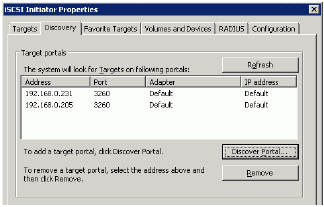
3. Click the Targets tab. The previously created targets are listed in the Discovered Targets section.
Note: If the created targets are not listed, check the firewall settings on the StarWind server as well as the list of networks served by the StarWind server. To check it, go to StarWind Management Console -> Configuration -> Network.
4. Select each target and click Connect.
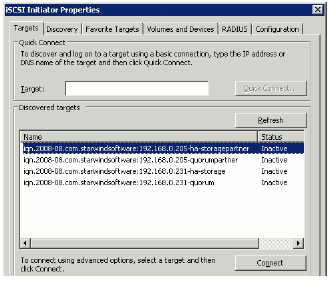
5. In the Connect to Target dialog box select Add this connection to the list of Favorite Targets and Enable multi-path check boxes. This is necessary to automatically reconnect to the targets after client restart.
6. Click Ok.

7. The iSCSI Initiator Properties window appears.
6. Now open MPIO manager by clicking Start -> Administrative Tools -> MPIO.
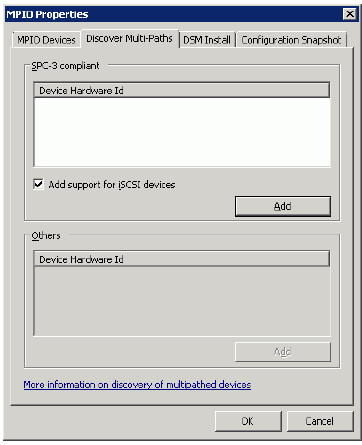
7. Go to the Discover Multi-Paths tab. Select the Add support for iSCSI devices check box and click Add. When prompted to restart the server, click Yes to proceed.
Note: Do not restart both nodes at the same time! First, restart one node, and wait until the device synchronization process is finished. Then, restart the second node.
8. After the server is restarted, initialize the disk and create partitions, as if it were physical hard drive.
Note: The procedures performed on the first server are automatically shown on the second one.
9. Launch Server Manager and go to the Disk Management section. Bring the available disks online and initialize them.
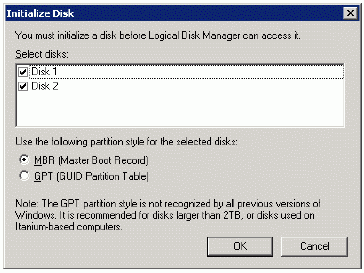
10. The Server Manager window appears. Two new empty disks are detected by the system.
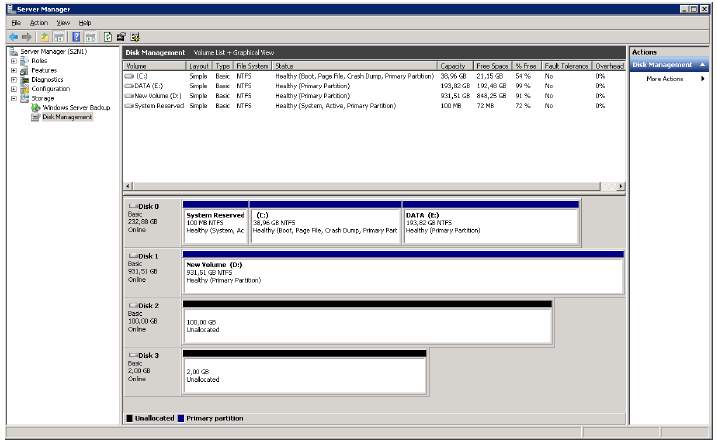
To create partitions and format new disks:
1. Right-click each of the disks, and select the New Simple Volume item from the Shortcut menu.
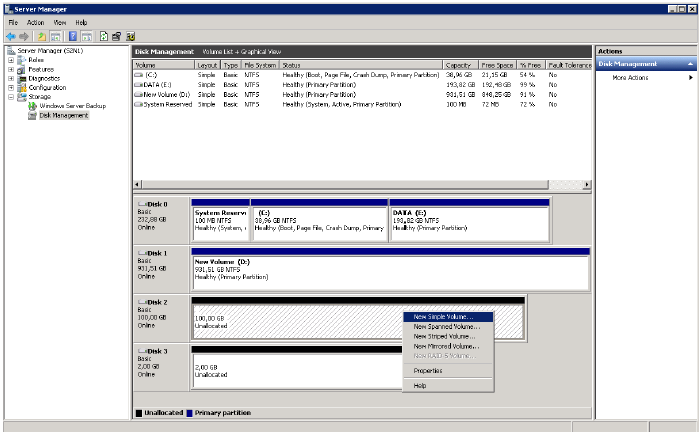
2. Follow the wizard’s instructions to create partitions. In the end the Server Manager window appears.
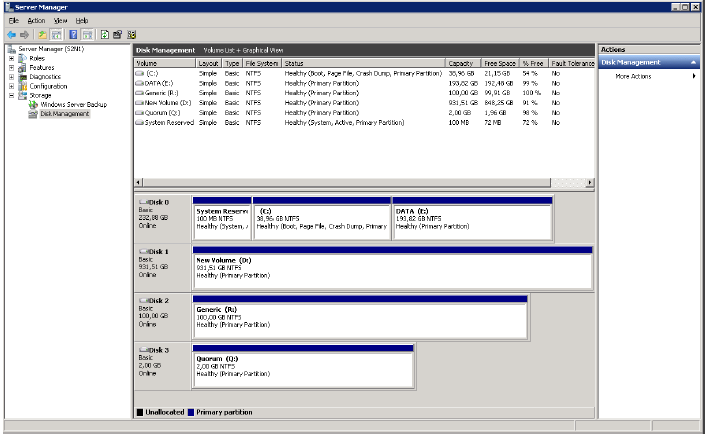
Follow the same procedure for the other servers, except that creating partitions is no longer necessary:
1. Launch Microsoft iSCSI Initiator, and click the Discovery tab.
2. Add IP address of the StarWind server to Target Portals.
3. Click the Targets tab and connect to the targets by selecting the Add this connection to the list of Favorite Targets and Enable multi-path checkboxes.
4. Launch Server Manager, go to the Disk Management section, and bring the available disks online. The Server Manager window appears.
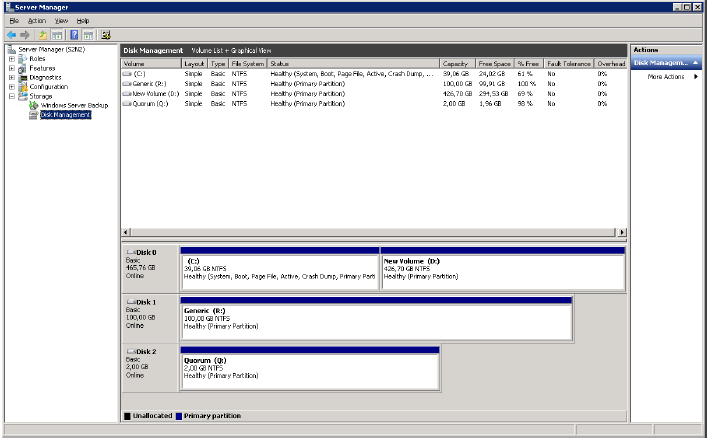
Creating a Cluster
To validate a cluster:
1. Open Server Manager. Expand the Features item on the Console tree and select the Failover Cluster Manager item.
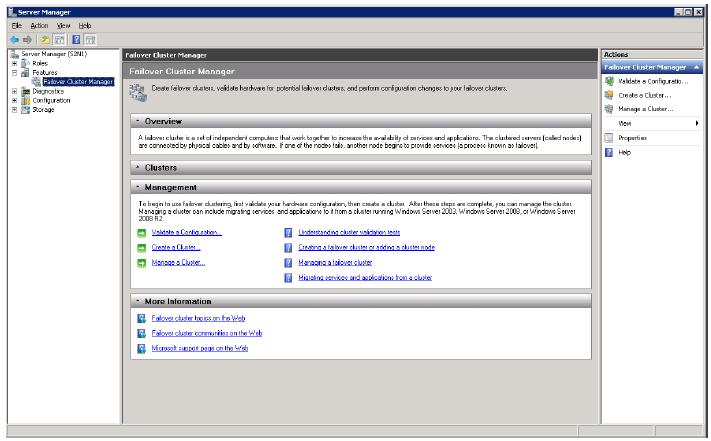
2. Before creating a cluster, you need to validate your configuration. In the Actions pane, click Validate a Configuration to verify whether your servers are suitable for building a cluster. As validation is completed, you are returned to the Failover Cluster Manager window.
To create a cluster:
1. Click the Create a Cluster item in the Actions pane.
2. Create Cluster Wizard appears. Click Browse to specify the servers that will be included into the cluster, or enter their names manually.

3. Click Next to continue.
4. Specify the cluster name.
Note: If IP addresses of the cluster servers are assigned by DHCP, the cluster’s IP address is also assigned by DHCP. If the IP addresses are set statically, you need to set an IP address for the cluster manually.

5. Click Next to continue.
6. Make sure that all of the previously defined options are correct. Click Previous to make any changes.
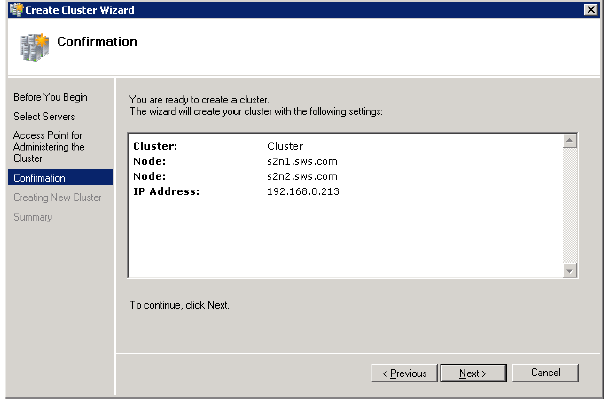
7. Click Next to continue.
8. The process of creating a cluster begins. After a cluster is created, a report with additional information appears. Click Finish to close the wizard.
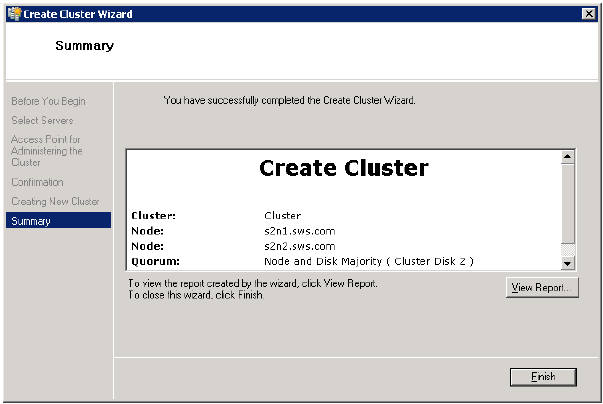
9. Failover Cluster Manager appears.

Enabling Cluster Shared Volumes
To enable Cluster Shared Volumes (CSV), perform the following actions:
1. Right-click the cluster, and click Enable Cluster Shared Volumes.

2. As CSV warning message appears, read it carefully.
Note: Use the CSV feature for its intended purpose only.
3. Click OK.
4. The Cluster Shared Volumes item appears in the Actions pane. Right-click this item, and select Add storage.

5. In the Add Storage dialog box that appears, specify the disk to be added.
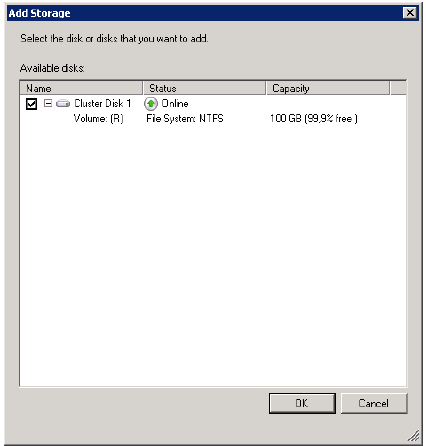
6. Click OK.
7. The Server Manager window appears.
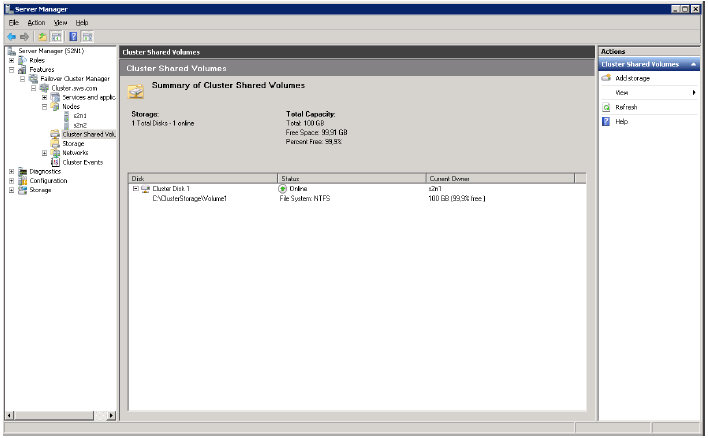
Creating a Highly Available Virtual Machine
To create an HA virtual machine:
1. Launch Server Manager.
2. Right-click the Services and applications and click Virtual Machines -> New Virtual Machine -> [host name].
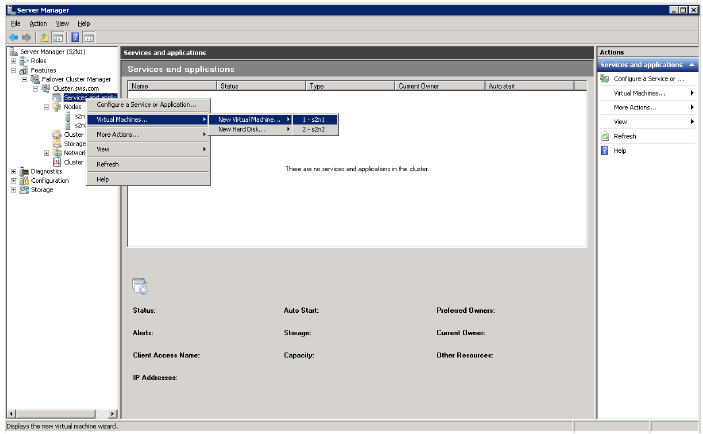
3. Specify the name and location of the virtual machine.
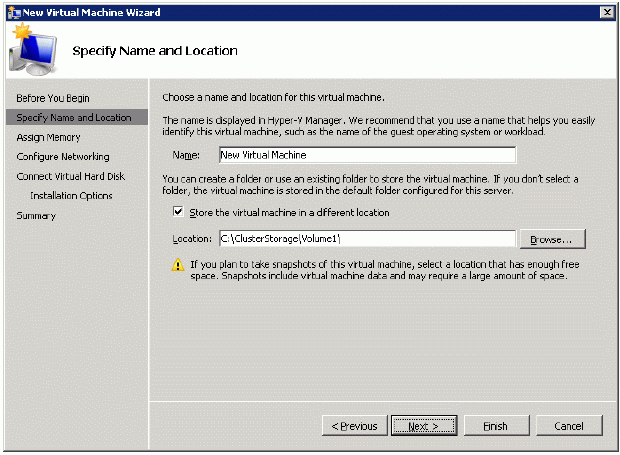
4. Click Next to continue.
5. Define the amount of memory to allocate to the virtual machine.
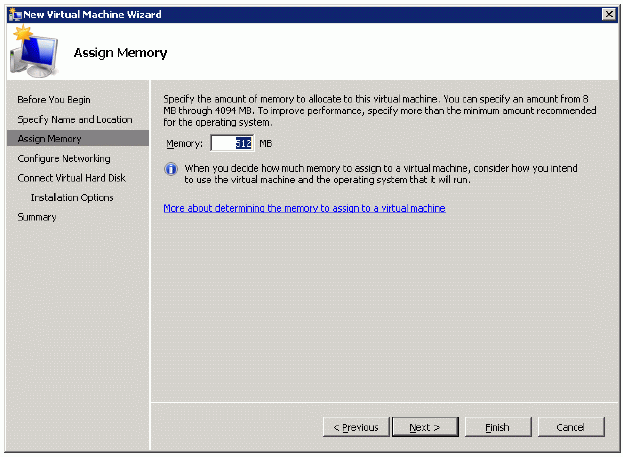
6. Click Next to continue.
7. Specify the necessary network connection options or leave the default parameters unchanged.

8. Click Next to continue.
9. Specify name, size and location of the virtual disk.
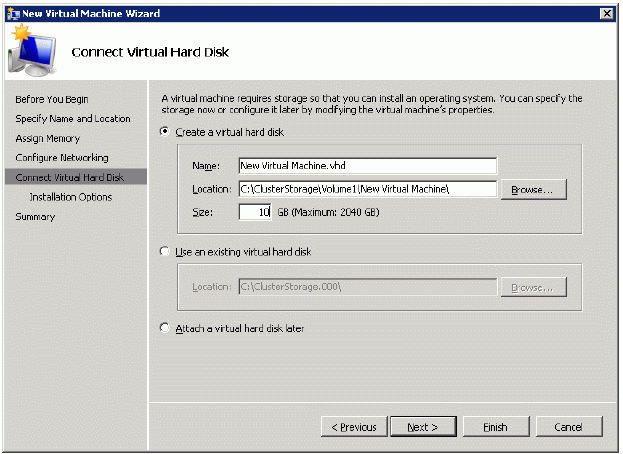
10. Click Next to continue.
11. Specify the installation options of the operating system or leave the default parameters unchanged.
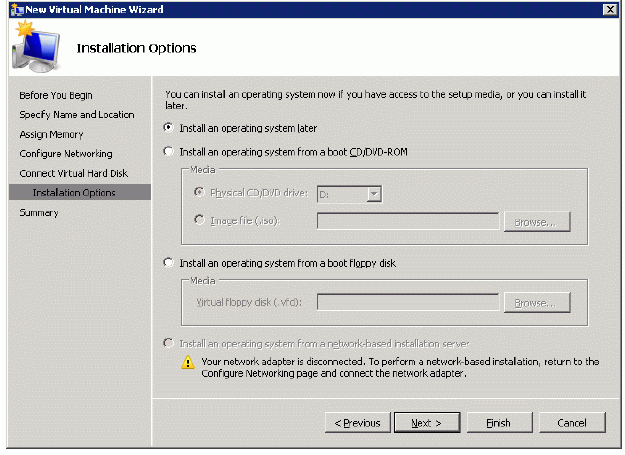
12. Click Next to continue.
13. Make sure that all of the parameters are correct. Click Previous to make any changes.

14. Click Finish to close the wizard.
15. Right-click the added virtual machine, and click Start virtual machines. The Server Manager window appears.

16. Check whether the virtual machine is running and operating successfully.
